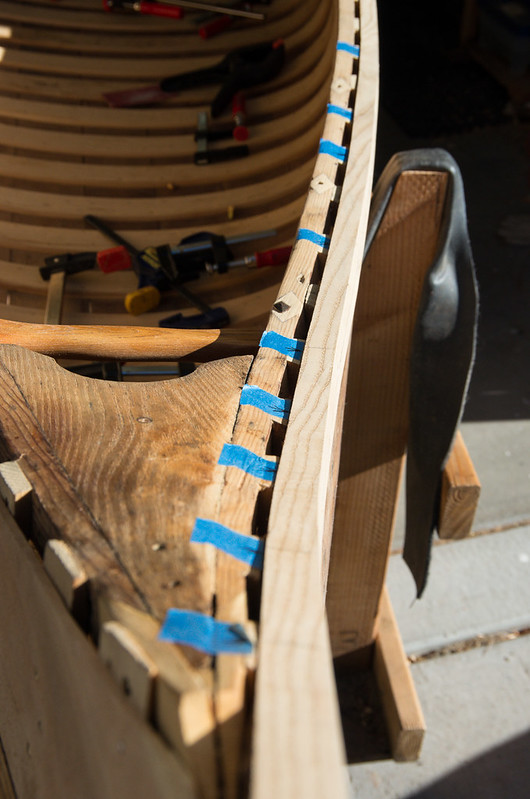A few comments.
First, keep in mind that Morris did not build canoes in the same way as Old Town, and probably not like anyone else. Much of what has been said above is basically the way Old Town did it, and while it can be adapted to a Morris being rebuilt, it pretty certainly is not just the way Morris did things. It is clear from photos that Morris did taper the ends of his gunwales, but most of my photos are or closed gunwale Morrises. I have only a couple of very poor pictures of what appears to be an open gunwale Morris, and one that has seen better days at that. Note the short top rails adjacent to, and extending a bit past, the decks.


You describe your canoe: “At the peaks the flange gradually disappears, the outwale is tapered. The ribs are let into the inwale and the planking edge is reduced to a feathered edge.” In the photo above, no flange or lip is needed at the end of the outwale; you can begin to taper it away at the point where the sheer plank (the top plank) loses its square edge and becomes a feathered edge. Warning -- this is pretty much just speculation on my part.
On Morrises with closed gunwales, the ribs are let into pockets for the whole length of the canoe; your canoe and these two pictures suggest that they used a little of their unique gunwale technique even on their open gunwale canoe.
However, the flange or lip on an Old Town outwale (at least on older ones) is not tapered, but is kept the same size while running the full length of the canoe, with the flange sitting atop the sheer plank the whole way. The lip that forms part of the top of the outwale is constant in size -- 5/32" x 5/32" on a 50 Pound model -- I would guess that the rabbet is cut first and the outwale is then fitted and tapered .

The body of the outwale outside the flange is where part of the outwale taper occurs. The original outwales on our 1931 OT 50 Pound model at midship are 15/16” high and 7/16” wide; at the ends, they are 9/16” high and 5/16” wide. The outwales are obviously less robust at the ends, right where some durability is called for -- all four outwale tips were battered on our 50 Pounder when we got it. On our 1922 OT Ideal, outwales are a bit more robust -- amidships they are 15/16” high and 5/8” wide, and at the ends, ¾” high and 7/16” wide. The ends on our Ideal are in great shape, most likely because it got better care than the 50 Pound model before we got them, but the extra size of the outwales certainly didn’t hurt anything.
The inwale and outwale do meet a few inches from the ends, adding an elegant touch when done right, something possible because the tops of the last three or so ribs are made progressively narrower, as shown on a friends OT 50 Pounder:
and my 50 Pounder with canvas and outwale removed:
On your Morris, the same effect is gained by recessing the last few ribs into pockets in the inwale.
When I got my 50 Pounder, the canvas had been replaced at least once. The person who put the last canvas on did not know how to do it. The unpainted canvas extended up and was folded over the top edge of the sheer plank and the extended up again above the rib ends. The outwale was fastened on with the canvas sandwiched between the outwale and the rib ends, and then trimmed even with the top edge of the gunwale. I suppose it was thought that this would fasten the canvas more securely. But the canvas was already fastened, and the lower edge of the outwale, when screwed down, would also secure the canvas. The extra unpainted canvas did nothing useful, but it did look ugly, especially where it frayed.


As to steaming, we had not pre-bent the gunwales that were fitted at the WCHA demonstration of steaming and fitting gunwales in a poly bag (post 11 above), and we had no problem fitting the outwale to the canoe. One of the advantages of steaming in a poly bag over using a steam box is that there is no need to rush to fit the steamed wood before it cools -- the continuous supply of steam keeps the piece flexible for as long as is needed while clamping the piece in place. A good supply of clamps is needed. The other major advantage of using poly tubing is that there is usually no need build a bending form, thereby saving significant time and some material.
Finally, I fully support any excuse that leads to getting a new tool. So if you “need” a Lie-Nielsen scratch stock to round over your gunwale edges, go for it. As King Lear cried, “O, reason not the need!” But you can do a fine job in a variety of ways other than using a scratch stock -- spoke shave, rasp, block plane, followed by sand paper.



